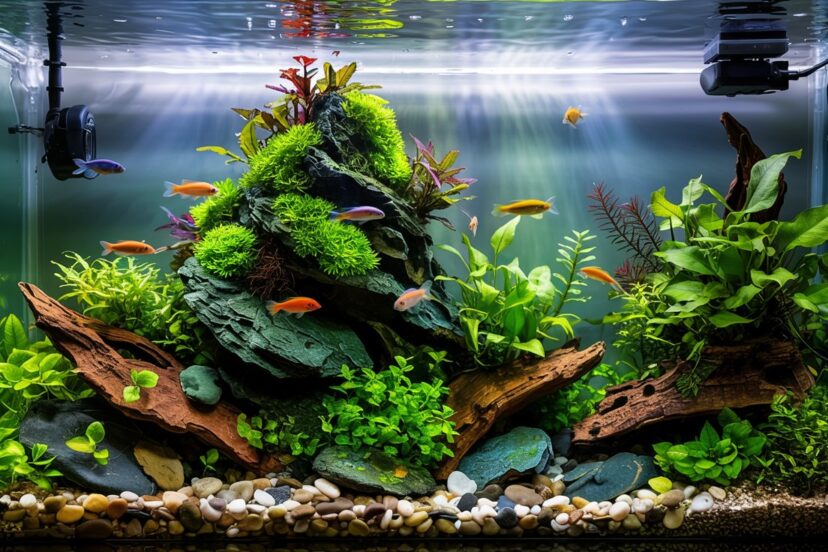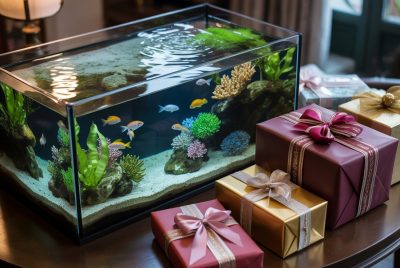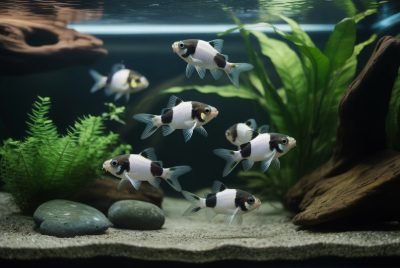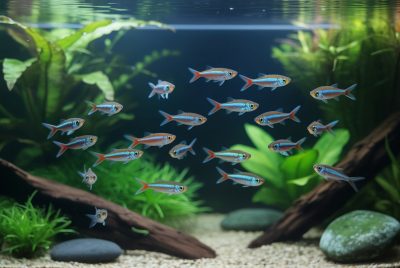The Ultimate 55 Gallon Aquascape Guide
*We may earn a commission for purchases made using our links. Please see our disclosure to learn more.
There’s something magical about creating a thriving underwater world in a 55-gallon aquarium. I still remember setting up my first large tank, the anticipation as I arranged driftwood and stones, carefully planted delicate stems, and finally watched the ecosystem come to life. A 55-gallon aquascape hits the sweet spot between creative possibility and practical maintenance, offering enough space to craft impressive landscapes while remaining accessible for hobbyists at any level.
Over the years, I’ve experimented with countless designs, plant combinations, and equipment setups. Through my successes (and occasional failures), I’ve developed techniques that help maximize the potential of this popular tank size. Whether you’re upgrading from a smaller aquarium or diving straight into the hobby with a 55-gallon, this guide will walk you through creating and maintaining a stunning aquatic display that will captivate viewers and provide endless satisfaction.
Key Takeaways:
- A 55-gallon tank offers the ideal balance of creative freedom and manageable maintenance for both beginners and experienced aquascapers
- Successful aquascaping requires understanding focal points, the rule of thirds, and creating depth through strategic hardscape and plant placement
- Substrate choice is crucial—consider specialized aquasoil for planted tanks or inert substrates for lower maintenance setups
- Lighting is the engine of your ecosystem—invest in quality LED systems with customizable settings for optimal plant growth
- Regular maintenance routines prevent algae issues and keep your aquascape looking its best
- The right equipment selection dramatically impacts both the health of your system and ease of maintenance
“Aquascaping is not just about creating beautiful underwater landscapes, but about fostering microenvironments where aquatic life can thrive naturally. The 55-gallon aquarium offers the perfect canvas for this blend of art and science.”
— Takashi Amano, Nature Aquarium World
Recommended Products for 55 Gallon Aquascape
After testing dozens of products in my own setups, here are my top recommendations that deliver excellent performance and value:
Fluval Plant 3.0 LED Light
The Fluval Plant 3.0 LED is a high-performance aquarium light designed for planted tanks, offering full-spectrum illumination to enhance plant growth and aquarium aesthetics. With customizable 24-hour light cycles and six unique band waves, this light provides optimal lighting conditions for a thriving aquatic environment. Its extendable mounting brackets ensure easy installation, making it a versatile choice for various tank sizes.
- Customizable Lighting: Features programmable 24-hour cycles, including sunrise, midday, sunset, and night modes.
- Full Spectrum Growth: Six unique band waves promote healthy plant growth and vibrant colors.
- Wide Coverage: 120-degree light dispersion ensures even illumination across the entire tank.
- Premium Price: Higher cost compared to basic aquarium lighting options.
- App-Dependent Controls: Requires a mobile app for full customization, which may not suit all users.
- Limited Waterproofing: Not fully submersible, so care is needed during maintenance.
This programmable LED provides customizable spectrum control and intensity settings perfect for promoting plant growth in a 55-gallon tank. Its sleek design and smartphone app control make it both functional and convenient.
ADA Aqua Soil Amazonia Ver.2
ADA’s Aqua Soil Amazonia Ver. 2 is a high-quality substrate designed to promote lush aquatic plant growth. Made from rare Japanese plant-based black soil, it provides essential nutrients and organic components for vibrant, healthy plants. This soil naturally buffers pH and water hardness, creating ideal conditions for aquatic ecosystems. With an included Amazon concentrate supplement, it enhances plant nutrition for a thriving, beautifully planted aquarium.
- Nutrient-Rich: Provides essential elements and organic components for plant growth.
- pH Balancing: Naturally lowers pH and hardness to optimal levels for aquatic plants.
- Ideal Granule Size: Promotes strong root development while maintaining a natural appearance.
- Initial Cloudiness: May cause temporary water cloudiness until settled.
- Nutrient Depletion: Requires supplementation over time as nutrients are absorbed.
- Higher Cost: More expensive than basic aquarium substrates.
This premium aquasoil provides ideal nutrient content and texture for plant growth. While more expensive than alternatives, its superior water buffering capacity and longevity make it worth the investment for serious plant-focused aquascapes.
Oase BioMaster Thermo 350 Canister Filter
The OASE Indoor Aquatics Biomaster Thermo 350 is a high-performance external aquarium filter designed for convenience, efficiency, and a cleaner aquatic environment. Ideal for aquariums up to 350 liters, this filter combines 4-stage filtration—mechanical, biological, chemical, and prefiltration—with an integrated heater to deliver consistent water quality and temperature. Its EasyClean prefilter module allows for quick maintenance without disturbing the main unit, while adjustable flow control ensures optimal water circulation. The compact design also helps maintain a clear view of your aquascape, making it perfect for serious hobbyists and aquascaping enthusiasts alike.
- Integrated Heater: Maintains precise, uniform temperature without additional equipment in your tank.
- Easy Maintenance: Removable prefilter module simplifies cleaning and extends filter life.
- Quiet Operation: Designed for silent running, ideal for indoor setups and living spaces.
- Higher Price Point: Premium features come at a higher cost compared to basic filters.
- Bulky Design: May require extra space beside or below your aquarium.
- Power Cord Required: Needs a nearby outlet; less ideal for tanks without accessible power.
This whisper-quiet filter combines excellent filtration with an integrated heater, reducing equipment clutter. Its pre-filter system makes maintenance significantly easier than standard canisters.
CO2Art Pro-Elite Series CO2 Regulator
The CO2 Art PRO-SE Series Dual Stage Regulator is designed for precision CO2 injection in planted aquariums. Featuring a dual-stage design, it prevents end-of-tank dumps, ensuring stable and consistent CO2 delivery. The adjustable working pressure allows customization for different aquarium setups, while the included needle valve and bubble counter provide fine control over CO2 flow. Built with durability in mind, this regulator is a reliable choice for aquascaping enthusiasts.
- Dual-Stage Design: Prevents end-of-tank dumps for stable CO2 delivery.
- Precise Control: Adjustable pressure, needle valve, and bubble counter for accuracy.
- Durable Build: Backed by a 5-year manufacturer’s warranty for long-term reliability.
- Higher Price: More expensive than basic CO2 regulators.
- Learning Curve: Requires some setup knowledge for optimal use.
- Tank Compatibility: Only fits CGA 320 standard threading CO2 tanks.
For high-tech planted setups, this dual-stage regulator provides precision control and reliability that prevents end-of-tank dumps. The quality construction and included solenoid make it a worthwhile investment for serious plant enthusiasts.
Understanding Aquascaping Principles for 55-Gallon Tanks
When I first designed my 55 gallon aquascape, I quickly discovered that the long, narrow dimensions create unique opportunities and challenges. The 48″ length offers excellent panoramic viewing but the relatively narrow 13″ width requires thoughtful planning to create depth.
Working with Proportions
The rectangular footprint of a 55 gallon aquascape makes it perfect for several popular aquascaping styles:
- Nature Aquarium – The length allows for creating impressive driftwood arrangements with multiple focal points
- Dutch Style – Perfect for showcasing a variety of colorful plant groups in structured arrangements
- Iwagumi – Though challenging in this format, modified Iwagumi layouts can work by emphasizing the front-to-back perspective
I’ve found that the key to success is embracing the tank’s proportions rather than fighting them. Instead of trying to create a square-looking layout in a rectangular tank, design with the natural viewing angles in mind.
Creating Depth in a Narrow Tank
The 13″ width presents a challenge for creating depth, but there are effective techniques to overcome this limitation:
- Terraced substrate – Building higher substrate at the back creates natural perspective
- Background plants – Tall stem plants in the rear corners create the illusion of distance
- Midground transitions – Using medium-height plants and hardscape to connect foreground and background elements
In my own tanks, I’ve found that angling hardscape materials like driftwood or stone from front-to-back rather than side-to-side dramatically enhances the sense of depth.
Essential Equipment for a Thriving 55-Gallon Aquascape
Filtration Systems
For my 55 gallon aquascape setups, I’ve always preferred canister filters for their combination of power and discretion. A quality canister rated for 200-250 gallons per hour provides the turnover needed without creating excessive current that could stress fish or uproot plants.
When selecting a filter, consider:
- Media capacity – Larger media chambers allow for more biological filtration
- Flow control – Adjustable output is essential for planted tanks
- Ease of maintenance – Quick-disconnect valves and accessible pre-filters save time
For those preferring hang-on-back filters, pairing two medium-sized units on opposite ends of the tank can provide adequate filtration while offering redundancy if one unit fails.
Lighting Considerations
Lighting is perhaps the most influential equipment choice you’ll make. For my planted 55 gallon aquascape, I’ve found that:
- LED intensity – Aim for fixtures providing 40-60 PAR at substrate level for medium-light plants
- Customizable spectrum – Adjustable red, green and blue channels allow tailoring light to specific plant needs
- Programmable timing – Gradual sunrise/sunset effects reduce stress on fish and prevent algae blooms
The 48″ length of a standard 55 gallon aquascape means you’ll need a substantial light fixture. I recommend investing in quality over saving a few dollars, as lighting determines what plants you can grow and ultimately how successful your aquascape will be.
Substrate Options
Your substrate choice should align with your aquascaping goals:
- Planted focus – Nutrient-rich aquasoils like ADA Amazonia, Fluval Stratum, or UNS Controsoil
- Fish focus – Inert substrates like sand or fine gravel that won’t alter water chemistry
- Hybrid approach – Base layer of nutrient-rich substrate capped with decorative sand or gravel
When I set up my planted 55-gallon tanks, I typically use 15-20 pounds of aquasoil per inch of substrate depth. For a nicely sloped layout, I’ll use 40-50 pounds total, building up the rear areas to 3-4 inches while keeping the foreground around 1-2 inches.
CO2 Systems: Worth the Investment?
While beautiful aquascapes are possible without CO2 injection, adding a pressurized system dramatically increases plant options and growth rates. For my high-tech 55-gallon setups, I use:
- 5lb CO2 cylinder (lasts 3-4 months before refill)
- Dual-stage regulator with solenoid
- In-line diffuser or reactor
- Drop checker for visual CO2 monitoring
The investment ranges from $200-400 for a complete setup, but the results in plant health and growth are remarkable. If you’re serious about creating a showcase aquascape, CO2 is well worth considering.
Plant Selection for 55 Gallon Aquascapes
When selecting plants for my 55 gallon aquascape, I consider growth patterns, maintenance requirements, and visual impact. Here’s how I approach plant selection for different areas:
Foreground Plants
The foreground creates the impression of an open landscape and draws the eye into the aquascape. My favorite options include:
- Dwarf Hairgrass (Eleocharis acicularis) – Creates lush, grass-like carpets with moderate light
- Monte Carlo (Micranthemum tweediei) – Faster growing than Hairgrass with attractive rounded leaves
- Marsilea Hirsuta – Clover-like appearance and very undemanding growth requirements
- Dwarf Sagittaria – Slightly taller option creating a savanna-like foreground
For carpeting plants, I’ve found that planting in small clumps about 1″ apart allows them to spread efficiently without leaving too much open substrate where algae could establish.
Midground Elements
The midground connects visual elements and creates transitions between areas. I typically use:
- Cryptocoryne wendtii varieties – Available in different colors and highly adaptable
- Staurogyne repens – Compact growth and bright green leaves make excellent focal points
- Anubias nana – Attaches to hardscape and thrives in shaded areas
- Bucephalandra varieties – Stunning leaf textures and colors for accent positions
Grouping similar plants together rather than individual specimens creates more natural-looking arrangements with greater visual impact.
Background Plants
Tall background plants provide structure and framing for the entire composition. For my 55 gallon aquascape, I regularly use:
- Vallisneria – Long, grass-like leaves create excellent texture and movement
- Hygrophila polysperma – Fast growing and adaptable stem plant
- Rotala rotundifolia – Turns beautiful red/pink with proper lighting and nutrients
- Limnophila sessiliflora – Feathery texture adds complexity to the background
When planting stem plants, I group them in threes and fives, placing taller species toward the back and slightly shorter varieties forward to create natural transitions.
Hardscape Selection and Arrangement
The hardscape forms the backbone of any aquascape, providing structure and focal points that guide the viewer’s eye.
Driftwood Options
For 55 gallon aquascape, I’ve had great success with these driftwood types:
- Spider wood – Intricate branching creates fascinating negative space
- Manzanita – Natural, twisted branches with a reddish hue
- Malaysian driftwood – Dense, darker wood that sinks immediately and ages beautifully
When arranging multiple pieces, I create connections between them to form unified structures rather than isolated elements. This approach creates more natural-looking compositions and provides additional attachment points for plants.
Stone Selection
The right stones can dramatically enhance your aquascape:
- Seiryu stone – Angular Japanese mountain stone with gray/blue tones
- Ohko stone (Dragon Stone) – Honeycomb texture and warm coloration
- Lava rock – Lightweight and excellent for plant attachment
I follow the odd-number rule when placing stones, typically using groups of three or five for natural asymmetry. Varying the sizes creates more dynamic compositions, with one dominant piece serving as the primary focal point.
Establishing and Maintaining Your 55-Gallon Aquascape
The Cycling Process
Before adding livestock to your newly established aquascape, cycling the tank is essential:
- After planting and filling, I add a source of ammonia (fish food or pure ammonia)
- Test water regularly to monitor ammonia, nitrite, and nitrate levels
- Add beneficial bacteria supplements to accelerate the process
- Wait until ammonia and nitrite read zero while nitrates are present
In planted tanks with aquasoil, I’ve found the cycling process typically takes 3-4 weeks. Using filter media from an established tank can significantly reduce this time.
Maintenance Routines
Consistent maintenance is the secret to a thriving aquascape. My routine for 55-gallon tanks includes:
Weekly Tasks:
- 25-30% water change
- Glass cleaning
- Filter intake/output wiping
- Trim fast-growing plants
- Test water parameters
- Dose fertilizers
Monthly Tasks:
- Deeper plant trimming and shaping
- Gravel/substrate vacuum in open areas
- Filter media rinsing (in tank water)
- Equipment inspection
Quarterly Tasks:
- Remove hardscape for deep cleaning if needed
- Major replanting or rearranging
- Replace carbon or chemical filtration media
- Check and replace CO2 equipment parts if needed
This schedule has kept my tanks algae-free and vibrant for years. The key is consistency rather than sporadic major cleanings.
Troubleshooting Common Issues
Algae Management
Every aquascaper faces algae challenges. My approach to common algae issues:
- Brown diatoms – Normal in new tanks; increases water changes and add algae eaters
- Hair algae – Reduce light intensity/duration and manually remove affected plants
- Green spot algae – Often indicates phosphate deficiency; adjust fertilization
- Black beard algae – Spot treat with hydrogen peroxide or Excel and improve CO2 distribution
The best algae prevention is a balanced system where plants outcompete algae for nutrients. This means adequate CO2, appropriate lighting, and consistent fertilization.
Plant Health Issues
When plants show signs of deficiency:
- Yellowing old leaves – Often nitrogen deficiency; increase comprehensive fertilization
- Stunted new growth – Possible calcium/magnesium issues; consider GH boosters
- Holes in leaves – Potassium deficiency; add targeted potassium supplements
- Melting plants – Normal transitioning for new plants; trim affected portions and be patient
I maintain detailed notes on my fertilization routines, allowing me to adjust specific nutrients rather than making multiple changes simultaneously.
Conclusion
Creating a 55-gallon aquascape has been one of the most rewarding aspects of this hobby for me. The perfect balance of creative possibilities and manageable maintenance makes this tank size ideal for both beginners and experienced aquascapers.
Remember that patience is essential, the most beautiful aquascapes develop over months as plants grow in and the system matures. Embrace the journey rather than focusing solely on the final result. Each maintenance session is an opportunity to guide your underwater garden’s evolution, making small adjustments that compound over time.
Whether you choose a minimalist Iwagumi style with carpeting plants and distinctive stones or a lush jungle scape overflowing with textures and colors, your 55 gallon aquascape offers endless creative possibilities. Start with quality equipment, follow sound principles, and maintain consistency, your reward will be a living piece of art that changes and evolves each day.
Frequently Asked Questions
1. How many fish can I keep in a 55-gallon planted aquascape?
I typically recommend stocking more conservatively in planted tanks than traditional setups. For a 55-gallon, I’ve had success with either:
- 25-30 small schooling fish (tetras, rasboras) divided into 2-3 compatible species
- 15-20 medium-sized fish (gouramis, rainbowfish)
- A combination of 1-2 centerpiece fish with smaller schooling companions
Remember that heavily planted tanks provide shelter and territory, allowing slightly higher stocking levels than bare tanks, but overcrowding remains the quickest way to destabilize your system.
2. How long will my aquascape last before needing a complete restart?
With proper maintenance, a 55-gallon aquascape can remain vibrant for 2-3 years before major renovation becomes necessary. Factors affecting longevity include:
- Substrate type (aquasoils gradually deplete after 12-24 months)
- Plant selection (fast-growing stems require more frequent replanting)
- Hardscape materials (some woods decompose faster than others)
I typically perform partial renovations rather than complete teardowns, replacing or refreshing one section at a time to maintain biological stability.
3. Can I create a successful 55-gallon aquascape without CO2 injection?
Absolutely! Many of my favorite 55-gallon setups have been low-tech systems. Keys to success without CO2 include:
- Choosing undemanding plants (Anubias, Java fern, Cryptocoryne, Bucephalandra)
- Moderate lighting (6-8 hours daily at lower intensity)
- Patient growth expectations (plants develop much slower)
- Possible liquid carbon supplements (Seachem Excel or similar)
Low-tech tanks often develop more stable, lower-maintenance ecosystems that require less frequent intervention.
4. What’s the best filter for a 55-gallon planted aquarium?
In my experience, canister filters provide the ideal combination of capacity, customization, and reduced in-tank equipment. For 55-gallon planted tanks, I recommend:
- Models rated for 200-250 gallons per hour
- Multiple-stage filtration with customizable media
- Spray bar or adjustable output to control flow pattern
Avoid over-filtering planted tanks, as excessive flow can stress fish and plants while potentially causing CO2 to dissipate too quickly.
5. How much should I budget for a complete 55-gallon aquascape setup?
Based on my setups, realistic budget ranges include:
- Basic Setup ($400-600): Standard lighting, HOB filter, basic substrate, limited hardscape
- Intermediate Setup ($700-1000): Quality LED lighting, canister filter, quality substrate, moderate hardscape
- Advanced Setup ($1200-1800): High-end LED lighting, premium filter, complete CO2 system, extensive hardscape and plant selection
I always recommend investing in quality equipment that will last for years rather than economy options that may need replacement. The most critical investments are lighting and filtration, which form the foundation of a successful system.















